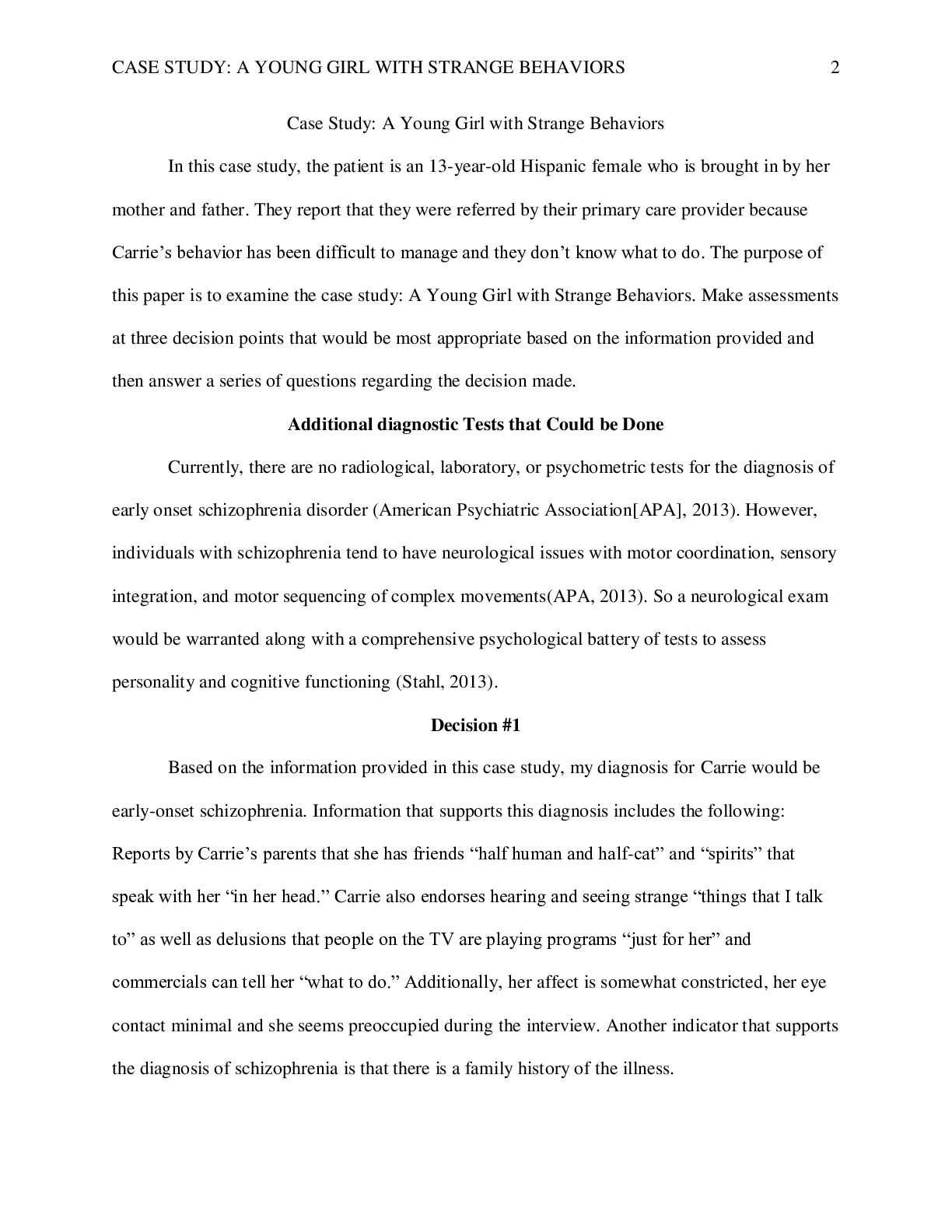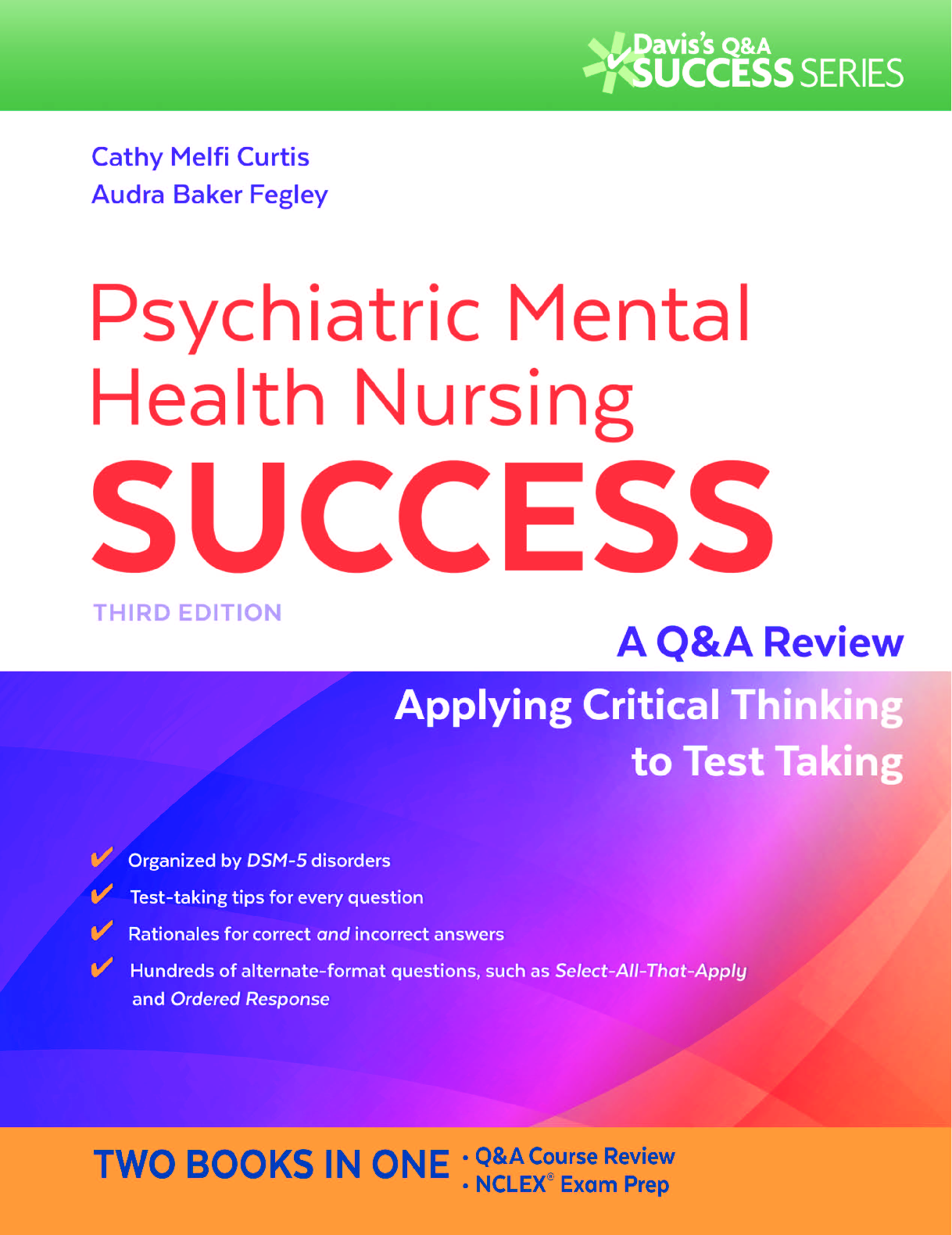Health Care > STUDY GUIDE > NURS 6660 Psychiatric Mental Health Course Schedule Nurse Practitioner Role I Child and Adolescent (All)
NURS 6660 Psychiatric Mental Health Course Schedule Nurse Practitioner Role I Child and Adolescent
Document Content and Description Below
© 2020 Laureate Education, Inc. Page 1 of 23 Course Schedule NURS 6660: Psychiatric Mental Health Nurse Practitioner Role I: Child and Adolescent This Course Schedule outlines the assignments and... due dates for the course. For full assignment details and directions, refer to the corresponding area in the course. • American Psychiatric Association. (2013). Diagnostic and statistical manual of mental disorders (5th ed.). Washington, DC: Author. o “Introduction” o “Use of the Manual” o “Cultural Formulation” • Kaplan, C. (2017). Ethical dilemmas. Advanced Healthcare Network. Retrieved from https://web.archive.org/web/20160416180027/http://nursepractitioners-and-physicianassistants.advanceweb.com/Article/Ethical-Dilemmas-2.aspx • Pumariega, A. J., Rothe, E., Mian, A., Carlisle, L., Toppelberg, C., Harris, T., . . . Smith, J. (2013). Practice parameter for cultural competence in child and adolescent psychiatric practice. Journal of the American Academy of Child & Adolescent Psychiatry, 52(10), 1101–1115. Retrieved from http://www.jaacap.com/article/S0890-8567(13)00479-6/pdf • American Academy of Child & Adolescent Psychiatry (AACAP). (2012b). Practice parameter for psychodynamic psychotherapy with children. Journal of the American Academy of Child & Adolescent Psychiatry, 51(5), 541–557. Retrieved from http://www.jaacap.com/article/S0890- 8567(12)00141-4/pdf • American Psychological Association. (2017). Code of Ethics. Retrieved from http://www.apa.org/ethics/code/ • Document: Child and Adolescent Diagnostic Assessment Worksheet (Word document) • Document: Practicum Journal Template (Word document) Media • Gajbhare, P. (2014, March 8). Mental status examination [Video file]. Retrieved from https://www.youtube.com/watch?v=VjWVYgf2UcU© 2017 Laureate Education, Inc. Page 3 of 23 Week 1 Comprehensive Integrated Psychiatric Assessment • YMH Boston. (2013a, May 22). Vignette 1 – Introduction to a preventive services visit [Video file]. Retrieved from https://www.youtube.com/watch?v=pQy-jwiu7gM • YMH Boston. (2013c, May 22). Vignette 4 – Introduction to a mental health assessment [Video file]. Retrieved from https://www.youtube.com/watch?v=JCJOXQa9wcE Discussion Comprehensive Integrated Psychiatric Assessment Post on or before Day 3: Based on the YMH Boston Vignette 4 video: • What did the practitioner do well? • In what areas can the practitioner improve? • At this point in the clinical interview, do you have any compelling concerns? If so, what are they? • What would be your next question, and why? Respond on or before Day 6 to at least two of your colleagues by offering additional insights or alternative perspectives on their diagnosis or provide alternate next questions and why you selected those. Assignment Practicum Journal Entry: Analyzing an Ethical Decision By Day 7 of Week 4 expected clinical outcomes. • Week 6: You will use one of your adult clients who had a psychiatric emergency as an example as you compare how you would assess a child or adolescent client who had a psychiatric emergency.© 2017 Laureate Education, Inc. Page 4 of 23 Week 1 Comprehensive Integrated Psychiatric Assessment • Week 7: You will work in a group to develop a “Parent Guide,” which will serve as a teaching tool for parents with children who have been diagnosed with a specific mental health disorder. • Week 10: You will work in a group to develop a “Parent Guide,” which will serve as a teaching tool for parents with children who have been diagnosed with a specific mental health disorder. Looking Ahead 2 Practicum Assignments Each week, you will complete practicum-related assignments. It is highly recommended that you review the practicum assignments for Weeks 2–11 before Day 7 of Week 1. This will give you time to meet with your preceptor so that you can fulfill the requirements of each practicum assignment. • Week 2: You begin working on your cover letter, resume, and portfolio. (Assignment to be submitted by Day 7 of Week 10.) • Week 3: You will complete a Decision Tree including the diagnosis and treatment of a pediatric client. (Assignment to be submitted by Day 7 of Week 4.) • Week 5: You will complete a Decision Tree including the diagnosis and treatment of a pediatric client. (Assignment to be submitted by Day 7 of Week 7.) • Week 6: You will write a reflection on your practicum experiences involving group therapy sessions. (Assignment to be submitted by Day 7 of Week 7.) • Week 7: You will write a journal entry concerning voluntary and involuntary commitment. (Assignment to be submitted by Day 7 of Week 7.) • Week 9: You will complete a Decision Tree including the diagnosis and treatment of a pediatric client. (Assignment to be submitted by Day 7 of Week 10.) • Week 10: You will write about two clients you observed or counseled during a group therapy session for children and adolescents. (Assignment to be submitted by Day 7 of Week 10.) • Week 10: You will complete and submit your cover letter, resume and portfolio. (Assignment to be submitted by Day 7 of Week 10.) Refer to Weeks 2–10 for additional guidance.© 2017 Laureate Education, Inc. Page 5 of 23 Week 2 Assessment in Child and Adolescent Psychiatry Resources Readings • Sadock, B. J., Sadock, V. A., & Ruiz, P. (2014). Kaplan & Sadock’s synopsis of psychiatry: Behavioral sciences/clinical psychiatry (11th ed.). Philadelphia, PA: Wolters Kluwer. o Chapter 2, “Contributions of the Psychosocial Sciences” (pp. 93–130) o Chapter 6, “Classification in Psychiatry” (pp. 290–299) o Chapter 31, “Child Psychiatry” (pp. 1107–1152) • American Psychiatric Association. (2013). Diagnostic and statistical manual of mental disorders (5th ed.). Washington, DC: preparation: Every detail is important when applying for a job. Advance Healthcare Network for NPs & PAs. Retrieved from https://web.archive.org/web/20160818183515/http://nursepractitioners-and-physicianassistants.advanceweb.com:80/Features/Articles/Cover-LetterResume-Preparation.aspx© 2017 Laureate Education, Inc. Page 6 of 23 Week 2 Assessment in Child and Adolescent Psychiatry • Walden University Career Services Center. (2017). Resumes & CVs: Home. Retrieved from http://academicguides.waldenu.edu/careerservices/resumesan dcvs • Document: Cover Letter, Resume, and Portfolio Assignment Guide (PDF) Discussion Working With Children and Adolescents Versus Adults Post on or before Day 3: • Explain why a developmental assessment of children and adolescents is important. • Describe two assessment instruments and explain why they are used for children and adolescents but not adults. • Describe two treatment options for children and adolescents that may not be used when treating adults. • Explain the role parents play in assessment and treatment. Respond on or before Day 6 to at least two of your colleagues by explaining which of the assessments they recommended would have the most utility to the patients in your practicum practice and why. Suggest at least one additional treatment area where your colleague may want to focus. Assignment Practicum: Cover Letter, Resume, and Portfolio By Day 7 of Week 10 Submit your Assignment. Looking Ahead You will be working with other colleagues within a wiki format to create Parent Guides in Weeks 3, 7, and 10. Your instructor will assign your group by Day 1 of Week 2. Week 3 Autism Spectrum Disorder, ADHD, ODD, and ICD Resources Readings • American Nurses Association. (2014). Psychiatric-mental health nursing: Scope and standards of practice (2nd ed.). Washington, DC: Author.© 2017 Laureate Education, Inc. Page 7 of 23 Week 3 Autism Spectrum Disorder, ADHD, ODD, and ICD • Standard 5E “Pharmacological, Biological and Integrative Therapies” (page 59) • Sadock, B. J., Sadock, V. A., & Ruiz, P. (2014). Kaplan & Sadock’s synopsis of psychiatry: Behavioral sciences/clinical psychiatry (11th ed.). Philadelphia, PA: Wolters Kluwer. o Chapter 3, “Contributions of the Sociocultural Sciences” (pp. 131–150) o Chapter 31, “Child Psychiatry” (pp. 1152–1181, 1244– 1253) • American Psychiatric Association. (2013). Diagnostic and statistical manual of mental disorders (5th ed.). Washington, DC: Author. o “Neurodevelopmental Disorders” Psychopharmacology (5th ed.). New York, NY: Cambridge University Press. Note: All Stahl resources can be accessed through the Walden Library using the link below. This link will take you to a login page for the Walden Library. Once you log in to the library, the Stahl website will appear. http://ezp.waldenulibrary.org/login?url=http://stahlonline.cambri dge.org/ Media • Laureate Education (Producer). (2017a). A young girl with difficulties in school [Multimedia file]. Baltimore, MD: Author. Discussion Parent Guide© 2017 Laureate Education, Inc. Page 8 of 23 Week 3 Autism Spectrum Disorder, ADHD, ODD, and ICD One group member Post by Day 5: • Using evidence-based research, design and develop a Parent Guide for your assigned disorder including: o Signs and symptoms o Pathophysiology o How the disorder is diagnosed o Treatment options • Provide a minimum of three academic references. Respond on or before Day 7 to at least two other groups by providing at least two contributions for improving or including in their parent guide and at least two things that you like about their guide. Assignment 1 Practicum: Decision Tree Submit by Day 7 of Week 4. Assignment 2 Board Vitals By Day 7 Complete the Board Vitals questions. Week 4 Trauma and Stressor-Related Disorders in Childhood Resources Readings • Sadock, B. J., Sadock, V. A., & Ruiz, P. (2014). Kaplan & Sadock’s synopsis of psychiatry: Behavioral sciences/clinical psychiatry (11th ed.). Philadelphia, PA: Wolters Kluwer. o Chapter 31, “Child Psychiatry” (pp. 1216–1226) • American Psychiatric Association. (2013). Diagnostic and statistical manual of mental disorders (5th ed.). Washington, DC: Author. o “Trauma- and Stressor-Related Disorders” • Pfefferbaum, B., & Shaw, J. A. (2013). Practice parameter on disaster preparedness. Journal of the American Academy of Child & Adolescent Psychiatry, 52(11), 1224–1238. Retrieved from http://www.jaacap.com/article/S0890-8567(13)00550- 9/pdf© 2017 Laureate Education, Inc. Page 9 of 23 Week 4 Trauma and Stressor-Related Disorders in Childhood • American Psychiatric Nurses Association. (2017). Childhood and adolescent trauma. Retrieved from http://www.apna.org/i4a/pages/index.cfm?pageID=4545 • Document: Childhood Abuse Case Study (PDF) • Stahl, S. M. (2014). Prescriber’s Guide: Stahl’s Essential Psychopharmacology (5th ed.). New York, NY: Cambridge University Press. Note: All Stahl resources can be accessed through the Walden Library using the link below. This link will take you to a login page for the Walden Library. Once you log in to the library, the Stahl website will appear. http://ezp.waldenulibrary.org/login?url=http://stahlonline.cambri dge.org/ Discussion Treating Childhood Abuse Post on or before Day 3: • What strategies would you employ to assess the patient for abuse? Explain why you selected these strategies. • How might exposure to the media and/or social media affect the patient? Submit your Assignment. Refer to Week 3 for additional guidance.© 2017 Laureate Education, Inc. Page 10 of 23 Week 4 Trauma and Stressor-Related Disorders in Childhood Assignment 3 Board Vitals By Day 7 Complete the Board Vitals questions. Practicum Reminder You are required to keep a log of the time you spend related to your practicum experience and enter every patient you see each day. You can access your time log from the Welcome Page in your Meditrek account. You track time individually for each patient you work with. Please make sure to continuously input your hours throughout the term. Week 5 Anxiety Disorders in Childhood and Adolescence Resources Readings • American Nurses Association. (2014). Psychiatric-mental health nursing: Scope and standards of practice (2nd ed.). Washington, DC: Author. • Standard 8 “Education” (pages 69-70) • Sadock, B. J., Sadock, V. A., & Ruiz, P. (2014). Kaplan & Sadock’s synopsis of psychiatry: Behavioral sciences/clinical psychiatry (11th ed.). Philadelphia, PA: Wolters Kluwer. o Chapter 31, “Child Psychiatry” (pp. 1253–1268) • American Psychiatric Association. (2013). Diagnostic and statistical manual of mental disorders (5th ed.). Washington, DC: Author. o “Anxiety Disorders” • American Academy of Child & Adolescent Psychiatry (AACAP). (2012a). Practice parameter for the assessment and treatment of children and adolescents with obsessivecompulsive disorder. Journal of the American Academy of Child & Adolescent Psychiatry, 51(1), 98–113. Retrieved from http://www.jaacap.com/article/S0890-8567(11)00882-3/pdf • McClelland, M., Crombez, M-M., Crombez, C., Wenz, C., Lisius, M., Mattia, A., & Marku, S. (2015). Implications for© 2017 Laureate Education, Inc. Page 11 of 23 Week 5 Anxiety Disorders in Childhood and Adolescence advanced practice nurses when pediatric autoimmune neuropsychiatric disorders associated with streptococcal infections (PANDAS) is suspected: A qualitative study. Journal of Pediatric Health Care, 29(5), 442–452. doi:10.1016/j.pedhc.2015.03.005 • Stahl, S. M. (2014). Prescriber’s Guide: Stahl’s Essential Psychopharmacology (5th ed.). New York, NY: Cambridge University Press. Note: All Stahl resources can be accessed through the Walden Library using the link below. This link will take you to a login page for the Walden Library. Once you log in to the library, the Stahl website will appear. http://ezp.waldenulibrary.org/login?url=http://stahlonline.cambr idge.org/ M https://www.youtube.com/watch?v=Gm3FLGxb2ZU • Laureate Education (Producer). (2017c). Anxiety disorder, OCD, or something else? [Multimedia file]. Baltimore, MD: Author. Discussion Clinical Supervision Post on or before Day 3 a 3- to 5-minute Kaltura video in which you do the following: • Describe the client. Note: Do not use the client’s actual names. • Explain your therapeutic approach with the client, including the perceived effectiveness of your approach. • Identify any additional information about this client that may potentially impact expected outcomes.© 2017 Laureate Education, Inc. Page 12 of 23 Week 5 Anxiety Disorders in Childhood and Adolescence Note: Nurse practitioners must have strong oral communication skills. This Discussion is designed to help you hone these skills. When filming your Kaltura video, be sure to dress and speak in a professional manner. Respond on or before Day 6 to at least two of your colleagues by suggesting an alternate therapeutic approach. Support your feedback with evidence-based literature and/or your own experiences with clients. Assignment 1 Practicum: Decision Tree Submit by Day 7 of Week 7. Assignment 2 Board Vitals By Day 7 Complete the Board Vitals questions. Looking Ahead You should be working on your cover letter, resume, and portfolio that is due in Week 10. Week 6 Emergency Psychiatric Care in Childhood and Adolescence Resources Readings • Sadock, B. J., Sadock, V. A., & Ruiz, P. (2014). Kaplan & Sadock’s synopsis of psychiatry: Behavioral sciences/clinical psychiatry (11th ed.). Philadelphia, PA: Wolters Kluwer. o Chapter 23, “Emergency Psychiatric Medicine” (pp. 785–790) o Chapter 31, “Child Psychiatry” (pp. 1226–1253) • American Psychiatric Association. (2013). Diagnostic and statistical manual of mental disorders (5th ed.). Washington, DC: Author. o “Bipolar and Related Disorders” • Stahl, S. M. (2014). Prescriber’s Guide: Stahl’s Essential Psychopharmacology (5th ed.). New York, NY: Cambridge University Press.© 2017 Laureate Education, Inc. Page 13 of 23 Week 6 Emergency Psychiatric Care in Childhood and Adolescence Note: All Stahl resources can be accessed through the Walden Library using the link below. This link will take you to a login page for the Walden Library. Once you log in to the library, the Stahl website will appear. http://ezp.waldenulibrary.org/login?url=http://stahlonline.cambr idge.org/ Discussion Treatment of Psychiatric Emergencies in Children Versus Adults Post on or by Day 3: • Briefly describe the case you selected. • Explain how you would treat the client differently if he or she were a child or adolescent. • Explain any legal or ethical issues you would have to consider when working with a child or adolescent emergency case. Respond on or before Day 6 to at least two of your colleagues by recommending at least one additional way you would treat a child or adolescent client differently than you would an adult and at least one additional way you would address the legal and ethical issues involved. Assignment 1 Midterm Exam • American Nurses Association. (2014). Psychiatric-mental health nursing: Scope and standards of practice (2nd ed.). Washington, DC: Author. • Standard 9 “Evidence-Based Practice and Research” (pages 71-72) • Sadock, B. J., Sadock, V. A., & Ruiz, P. (2014). Kaplan & Sadock’s synopsis of psychiatry: Behavioral sciences/clinical psychiatry (11th ed.). Philadelphia, PA: Wolters Kluwer. o Chapter 4, “Theories of Personality and Psychopathology” (pp. 151–191) o Chapter 31, “Child Psychiatry” (pp. 1181–1205) • American Psychiatric Association. (2013). Diagnostic and statistical manual of mental disorders (5th ed.). Washington, DC: Author. o “Neurodevelopmental Disorders” Specific Learning Disorder Motor Disorders • Murphy, T. K., Lewin, A. B., Storch, E. A., Stock, S. (2013). Practice parameter for the assessment and treatment of children and adolescents with tic disorders. Journal of the American Academy of Child & Adolescent Psychiatry, 52(12), 1341–1359. Retrieved from http://www.jaacap.com/article/S0890-8567(13)00695-3/pdf • McGarvey, E. L., Leon-Verdin, M., Wancheck, T. N., & Bonnie, R. J. (2013). Decisions to initiate involuntary commitment: The role of intensive community services and other factors. Psychiatric Services, 64(2), 120–126. Retrieved from http://search.proquest.com.ezp.waldenulibrary.org/docview/14 44016418?accountid=14872 • Kaltiala-Heino, R. (2010). Involuntary commitment and detainment in adolescent psychiatric inpatient care. Social Psychiatry and Psychiatric Epidemiology, 45(8), 785–793. doi:10.1007/s00127-009-0116-3 • Lindsey, M. A., Joe, S., Muroff, J., & Ford, B. E. (2010). Social and clinical factors associated with psychiatric emergency© 2017 Laureate Education, Inc. Page 15 of 23 Week 7 Learning and Motor Disorders in Childhood service use and civil commitment among African-American youth. General Hospital Psychiatry, 32(3), 300–309. doi:10.1016/j.genhosppsych.2010.01.007 • Stahl, S. M. (2014). Prescriber’s Guide: Stahl’s Essential Psychopharmacology (5th ed.). New York, NY: Cambridge University Press. Note: All Stahl resources can be accessed through the Walden Library using the link below. This link will take you to a login page for the Walden Library. Once you log in to the library, the Stahl website will appear. h o Signs and symptoms o Pathophysiology o How the disorder is diagnosed o Treatment options • Provide a minimum of three academic references. Respond on or before Day 7 to at least two other groups by providing at least two contributions for improving or including in their Parent Guide and at least two things that you like about their guide. Assignment 1 Practicum Journal: Voluntary and Involuntary Commitment By Day 7 of Week 7 Submit your Assignment. Assignment 2 Practicum: Week 5 Decision Tree By Day 7 Submit your Assignment. Refer to Week 5 for additional guidance. Assignment 3 Board Vitals© 2017 Laureate Education, Inc. Page 16 of 23 Week 7 Learning and Motor Disorders in Childhood By Day 7 Complete the Board Vitals questions. Practicum Reminder Time Logs You are required to keep a log of the time you spend related to your practicum experience and enter every patient you see each day. You can access your time log from the Welcome Page in your Meditrek account. You track time individually for each patient you work with. Please make sure to continuously input your hours. Week 8 Mood Disorders Resources Readings • Sadock, B. J., Sadock, V. A., & Ruiz, P. (2014). Kaplan & Sadock’s synopsis of psychiatry: Behavioral sciences/clinical psychiatry (11th ed.). Philadelphia, PA: Wolters Kluwer. o Chapter 31, “Child Psychiatry” (pp. 1226–1253) • American Psychiatric Association. (2013). Diagnostic and statistical manual of mental disorders (5th ed.). Washington, DC: Author. o “Bipolar and Related Disorders” o “Depressive Disorders” • Zeanah, C. H., Chesher, T., & Boris, N. W. (2016). Practice parameter for the assessment and treatment of children and adolescents with reactive attachment disorder and disinhibited social engagement disorder. Journal of the American Academy of Child & Adolescent Psychiatry, 55(11), 990–103. Retrieved from http://www.jaacap.com/article/S0890-8567(16)31183- 2/pdf • Stahl, S. M. (2014). Prescriber’s Guide: Stahl’s Essential Psychopharmacology (5th ed.). New York, NY: Cambridge University Press. Note: All Stahl resources can be accessed through the Walden Library using the link below. This link will take you to a login page for the Walden Library. Once you log in to the ering their argument with evidence. Identify at least two consequences to support your position. Assignment Board Vitals By Day 7 Complete the Board Vitals questions. Looking Ahead 1 In Week 9, you will work with our group again to create a new Parent Guide, focusing on feeding, eating, and elimination disorders in childhood. Looking Ahead 2 You should be working on your cover letter, resume, and portfolio that is due in Week 10. Week 9 Early-Onset Schizophrenia Resources Readings • American Nurses Association. (2014). Psychiatric-mental health nursing: Scope and standards of practice (2nd ed.). Washington, DC: Author. • Standard 10 “Quality of Practice” (pages 73-74) • Sadock, B. J., Sadock, V. A., & Ruiz, P. (2014). Kaplan & Sadock’s synopsis of psychiatry: Behavioral sciences/clinical psychiatry (11th ed.). Philadelphia, PA: Wolters Kluwer. o Chapter 31, “Child Psychiatry” (pp. 1268–1283)© 2017 Laureate Education, Inc. Page 18 of 23 Week 9 Early-Onset Schizophrenia • American Psychiatric Association. (2013). Diagnostic and statistical manual of mental disorders (5th ed.). Washington, DC: Author. o “Schizophrenia Spectrum and Other Psychotic Disorders” • McClellan, J., & Stock, S. (2013). Practice parameter for the assessment and treatment of children and adolescents with schizophrenia. Journal of the American Academy of Child & Adolescent Psychiatry, 52(9), 976–990. Retrieved from http://www.jaacap.com/article/S0890-8567(13)00112-3/pdf • Giles, L. L., & Martini, D. R. (2016). Challenges and promises of pediatric psychopharmacology. Academic Pediatrics, 16(6), 508–518. doi:10.1016/j.acap.2016.03.011 • Hargrave, T. M., & Arthur, M. E. (2015). Teaching child psychiatric assessment skills: Using pediatric mental health screening tools. International Journal of Psychiatry in Medicine, 50(1), 60–72. Retrieved from http://search.proquest.com.ezp.waldenulibrary.org/docview/17 02699596?accountid=14872 • Stahl, S. M. (2014). Prescriber’s Guide: Stahl’s Essential Psychopharmacology (5th ed.). New York, NY: Cambridge University Press. Note: All Stahl resources can be accessed through the Walden Library using the link below. This link will take you to a login page for the Walden Library. Once you log in to the library, the Stahl website will appear. http://ezp.waldenulibrary.org/login?url=http://stahlonline.cambri dge.org/ Media • Laureate Education (Producer). (2017b). A young girl with & Ruiz, P. (2014). Kaplan & Sadock’s synopsis of psychiatry: Behavioral sciences/clinical psychiatry (11th ed.). Philadelphia, PA: Wolters Kluwer. o Chapter 28, “Psychotherapies” (pp. 901–907) o Chapter 31, “Child Psychiatry” (pp. 1205–1216) • American Psychiatric Association. (2013). Diagnostic and statistical manual of mental disorders (5th ed.). Washington, DC: Author. o “Feeding and Eating Disorders” o “Elimination Disorders” • Lock, J., & La Via, M. C. (2015). Practice parameter for the assessment and treatment of children and adolescents with eating disorders. Journal of the American Academy of Child & Adolescent Psychiatry, 54(5), 412–425. Retrieved from http://www.jaacap.com/article/S0890-8567(15)00070-2/pdf • Stahl, S. M. (2014). Prescriber’s Guide: Stahl’s Essential Psychopharmacology (5th ed.). New York, NY: Cambridge University Press. Note: All Stahl resources can be accessed through the Walden Library using the link below. This link will take you to a login page for the Walden Library. Once you log in to the© 2017 Laureate Education, Inc. Page 20 of 23 Week 10 Feeding, Eating, and Elimination Disorders in Childhood library, the Stahl website will appear. http://ezp.waldenulibrary.org/login?url=http://stahlonline.cambr idge.org/ Discussion Parent Guide One group member Post by Day 5: • Using evidence-based research, design and develop a Parent Guide for your assigned disorder including: o Signs and symptoms o Pathophysiology o How the disorder is diagnosed o Treatment options • Provide a minimum of three academic references. Respond on or before Day 7 to at least two other groups by providing at least two contributions for improving or including in their Parent Guide and at least two things that you like about their guide. Assignment 1 Practicum: Week 2 Cover Letter, Resume, and Portfolio By Day 7 Submit your cover letter, resume, and portfolio, which were assigned in Week 2. Assignment 2 Practicum: Week 9 Decision Tree By Day 7 Submit your Assignment. Refer to Week 9 for additional guidance. Assignment 3 Board Vitals By Day 7 Complete the Board Vitals questions. Practicum Reminder Time Logs You are required to keep a log of the time you spend related to your practicum experience and enter every patient you see each day. You can access your time log from the Welcome Page in your Meditrek account. You track time individually for each patient you work with. Please make sure to continuously input your hours.© 2017 Laureate Education, Inc. Page 21 of 23 Week 10 Feeding, Eating, and Elimination Disorders in Childhood Week 11 Special Topics in Child and Adolescent Psychiatry Resources Readings • American Nurses Association. (2014). Psychiatric-mental health nursing: Scope and standards of practice (2nd ed.). Washington, DC: Author. • Standards 11 “Communication” (page 75) • Sadock, B. J., Sadock, V. A., & Ruiz, P. (2014). Kaplan & Sadock’s synopsis of psychiatry: Behavioral sciences/clinical psychiatry (11th ed.). Philadelphia, PA: Wolters Kluwer. o Chapter 31, “Child Psychiatry” (pp. 1279–1323) • American Psychiatric Association. (2013). Diagnostic and statistical manual of mental disorders (5th ed.). Washington, DC: Author. o “Somatic Symptom and Related Disorders” o “Other Conditions That May Be a Focus of Clinical Attention” o “Assessment Measures” o “Cultural Formulation” • American Academy of Child & Adolescent Psychiatry (AACAP). (2011). Practice parameter for child and adolescent forensic evaluations. Journal of the American Academy of Child & Adolescent Psychiatry, 50(12), 1299–1312. Retrieved from http://www.jaacap.com/article/S0890-8567(11)00883- 5/pdf • American Academy of Child & Adolescent Psychiatry (AACAP). (2012c). Practice parameter on gay, lesbian, or bisexual sexual orientation, gender nonconformity, and gender discordance in children and adolescents. Journal of the American Academy of Child & Adolescent Psychiatry, 51(9), 957–974. Retrieved from http://www.jaacap.com/article/S0890- 8567(12)00500-X/pdf • Lee, T., Fouras, G., & Brown, R. (2015). Practice parameter for the assessment and management of youth involved with the© 2017 Laureate Education, Inc. Page 22 of 23 Week 11 Special Topics in Child and Adolescent Psychiatry child welfare system. Journal of the American Academy of Child & Adolescent Psychiatry, 54(6), 502–517. Retrieved from http://www.jaacap.com/article/S0890-8567(15)00148-3/pdf • Human Rights Campaign. (n.d.). Growing up LGBT in America. Retrieved June 8, 2017, from http://assets.hrc.org//files/assets/resources/Growing-Up-LGBTinAmerica_Report.pdf?_ga=1.83582870.1279387255.14932247 49 exam, you should review all of your materials. There is a 2-hour time limit to complete this 75-question exam. You may only attempt this exam once. Assignment 2 Board Vitals© 2017 Laureate Education, Inc. Page 23 of 23 Week 11 Special Topics in Child and Adolescent Psychiatry By Day 7 Complete the Board Vitals questions. Course Evaluation Complete your Course Evaluation by Day 7. [Show More]
Last updated: 1 year ago
Preview 1 out of 23 pages

Reviews( 0 )
Document information
Connected school, study & course
About the document
Uploaded On
Aug 22, 2020
Number of pages
23
Written in
Additional information
This document has been written for:
Uploaded
Aug 22, 2020
Downloads
0
Views
46

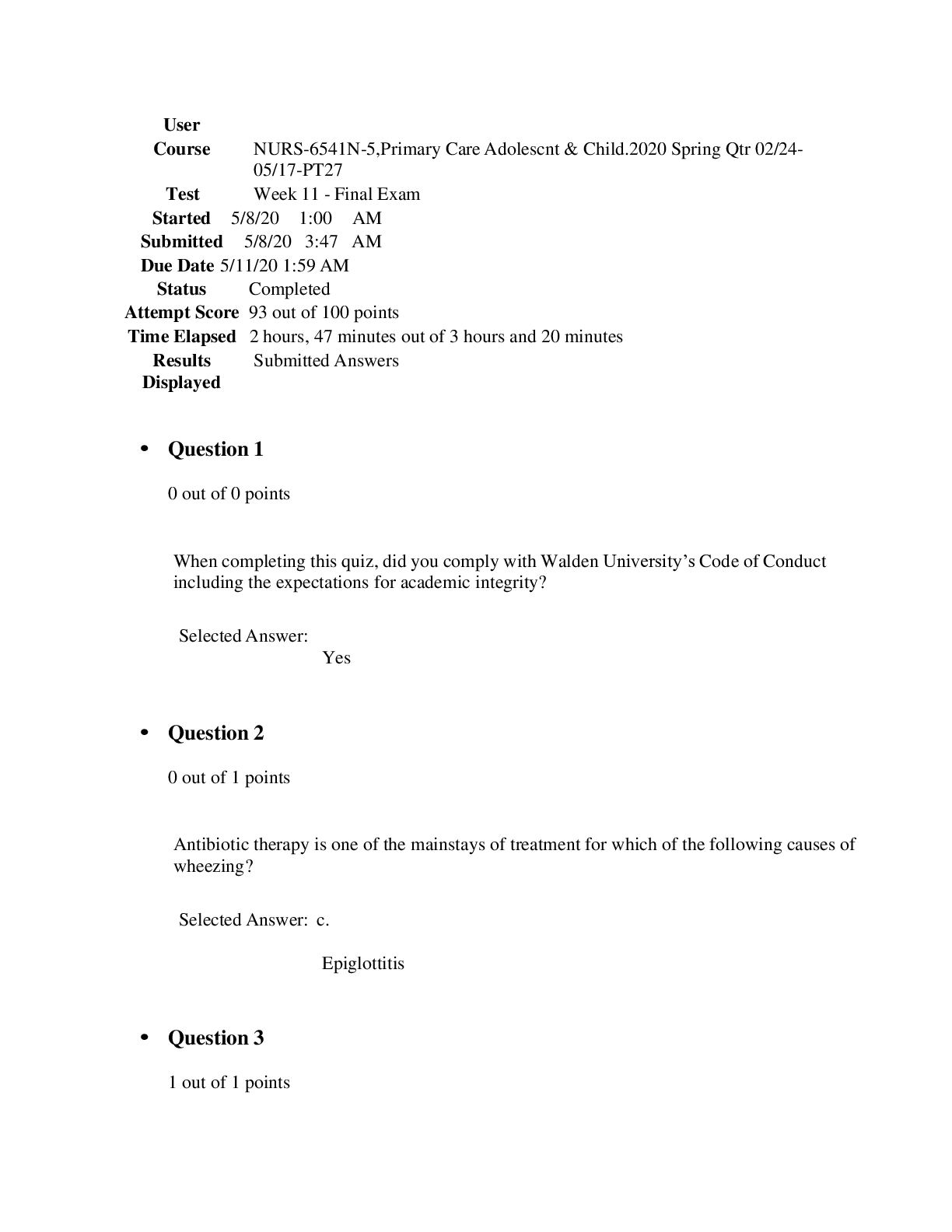
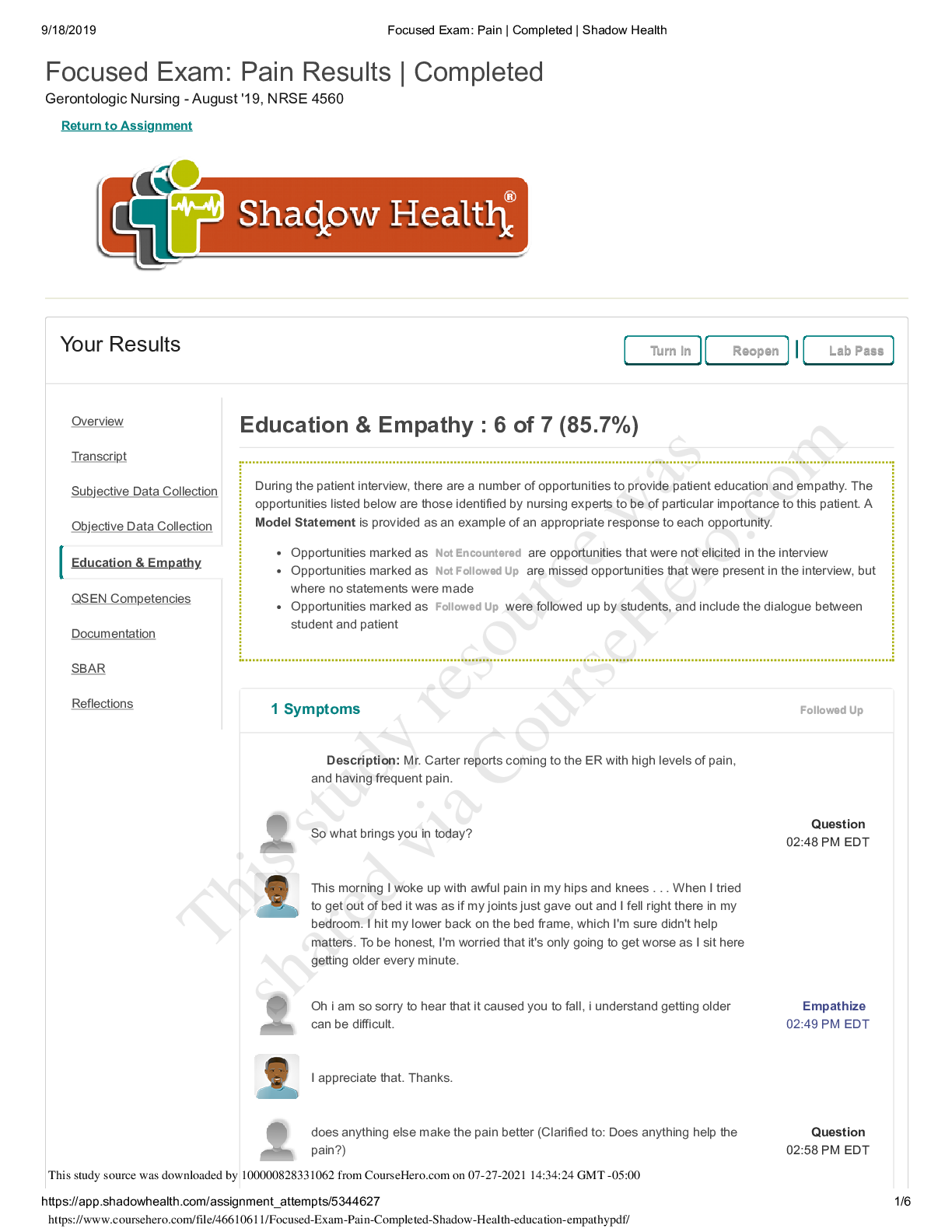

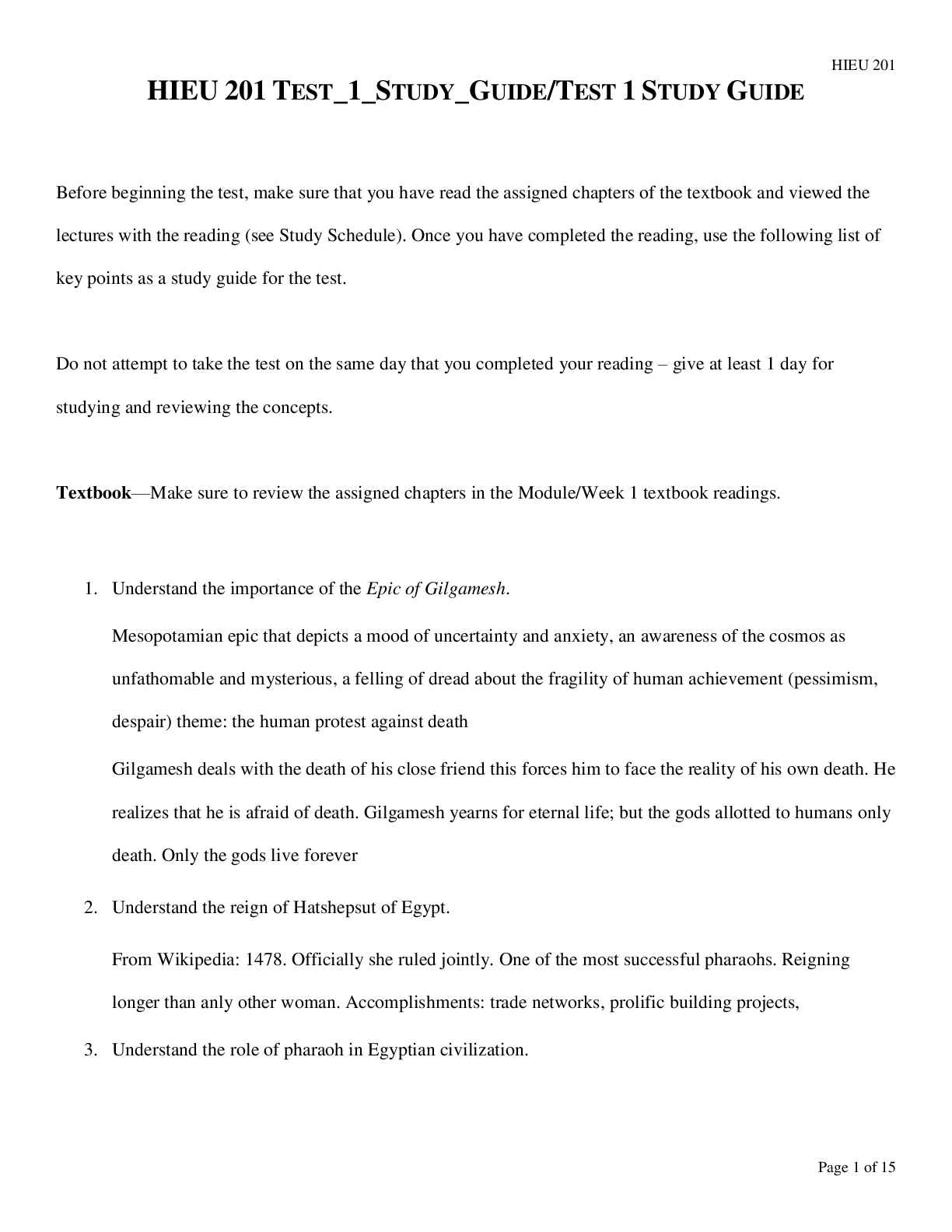



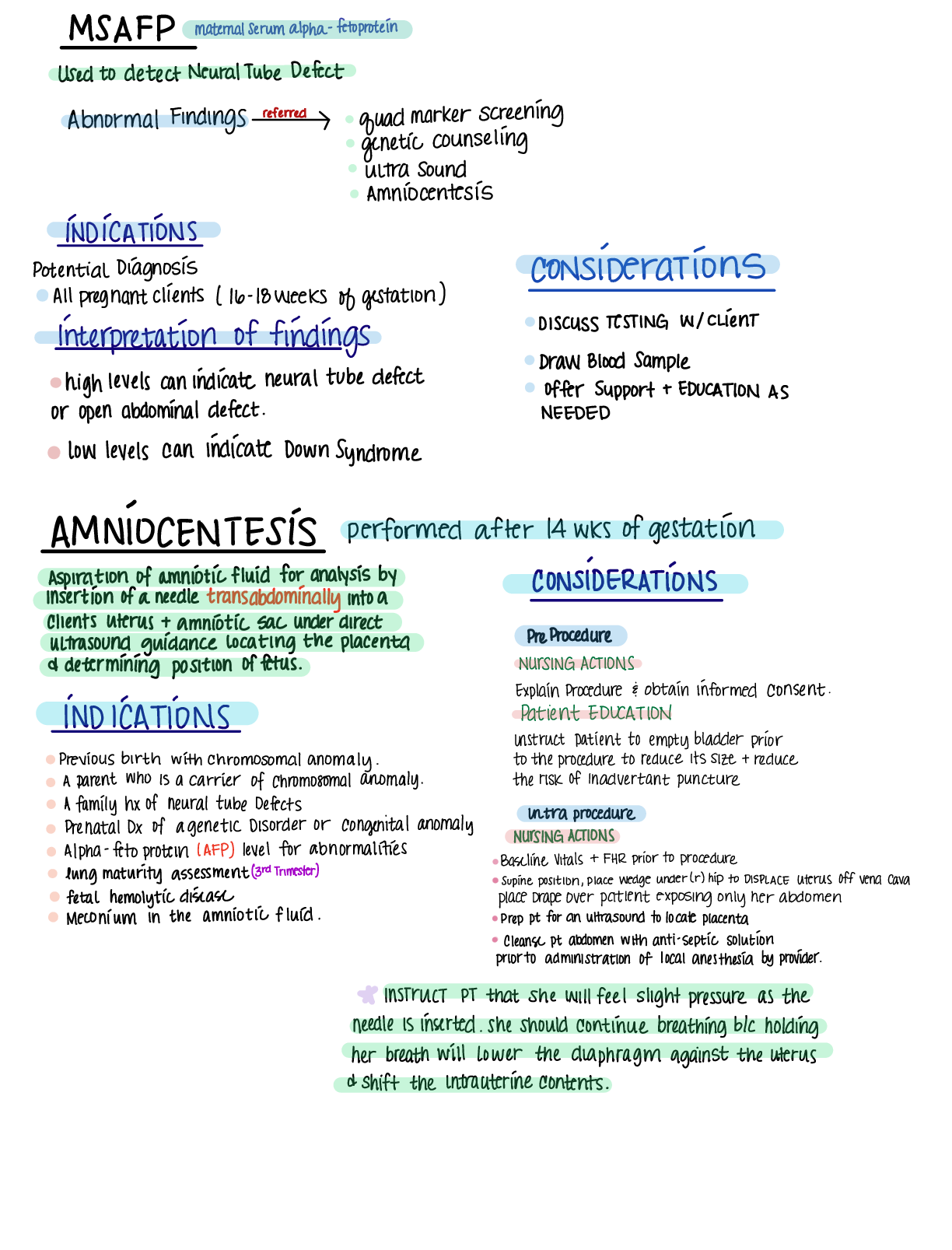


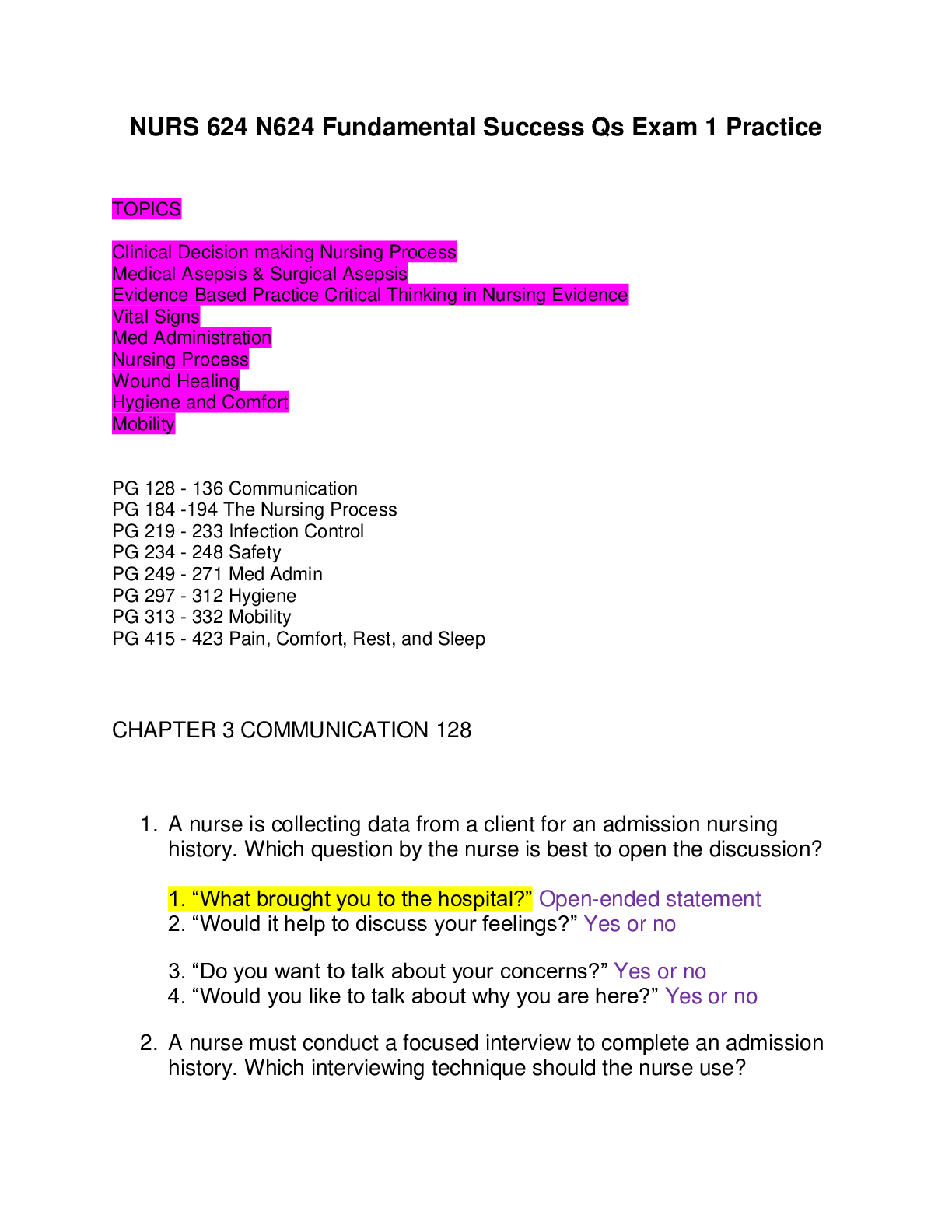
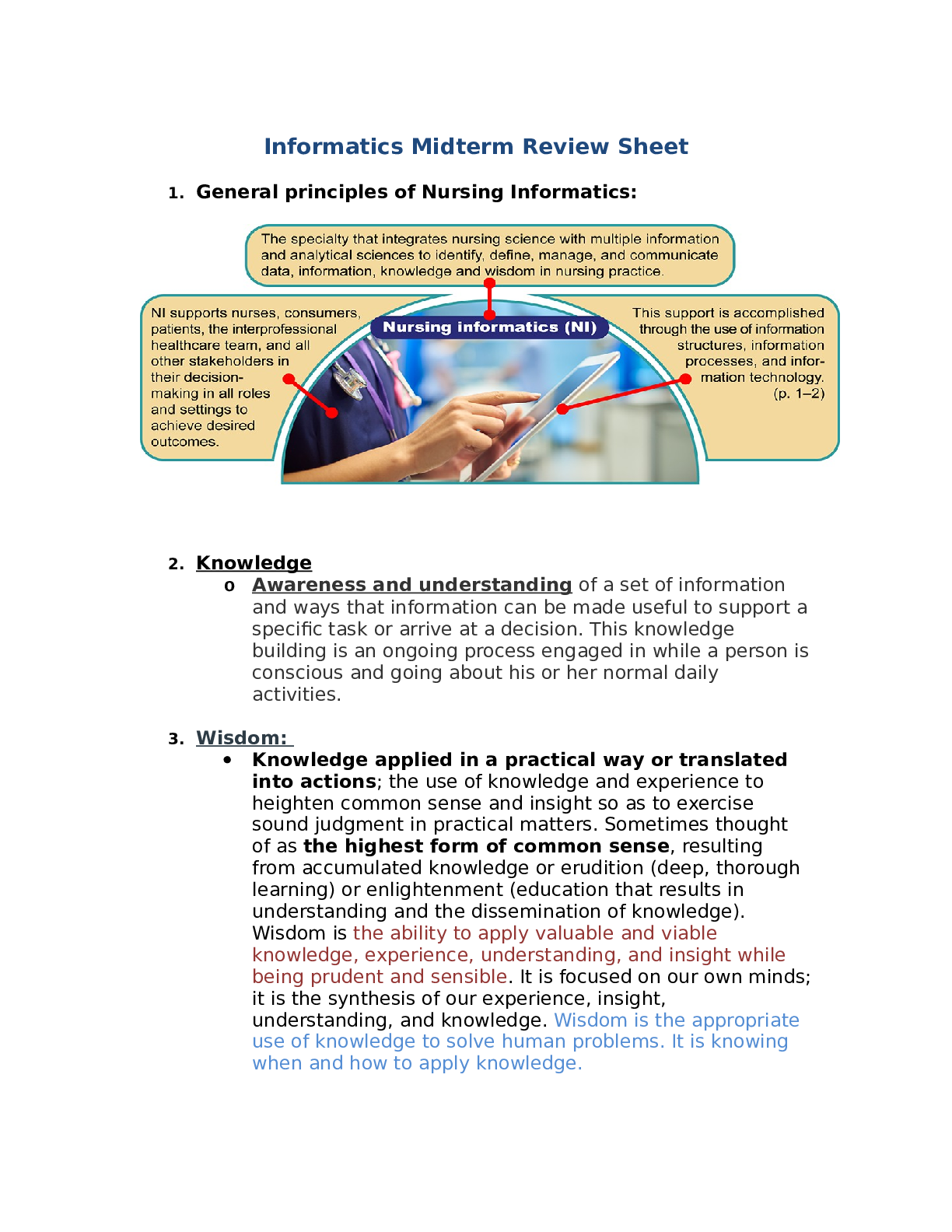
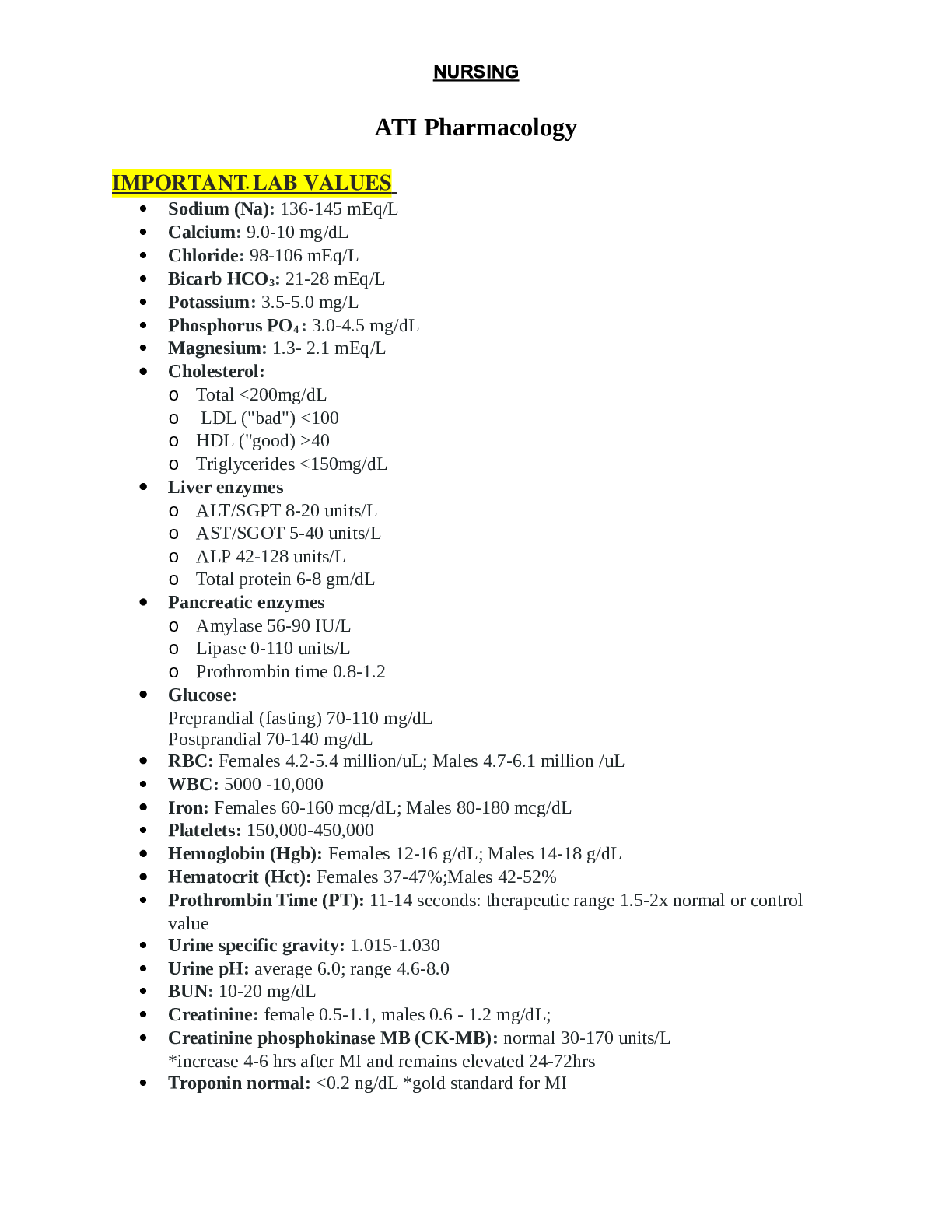

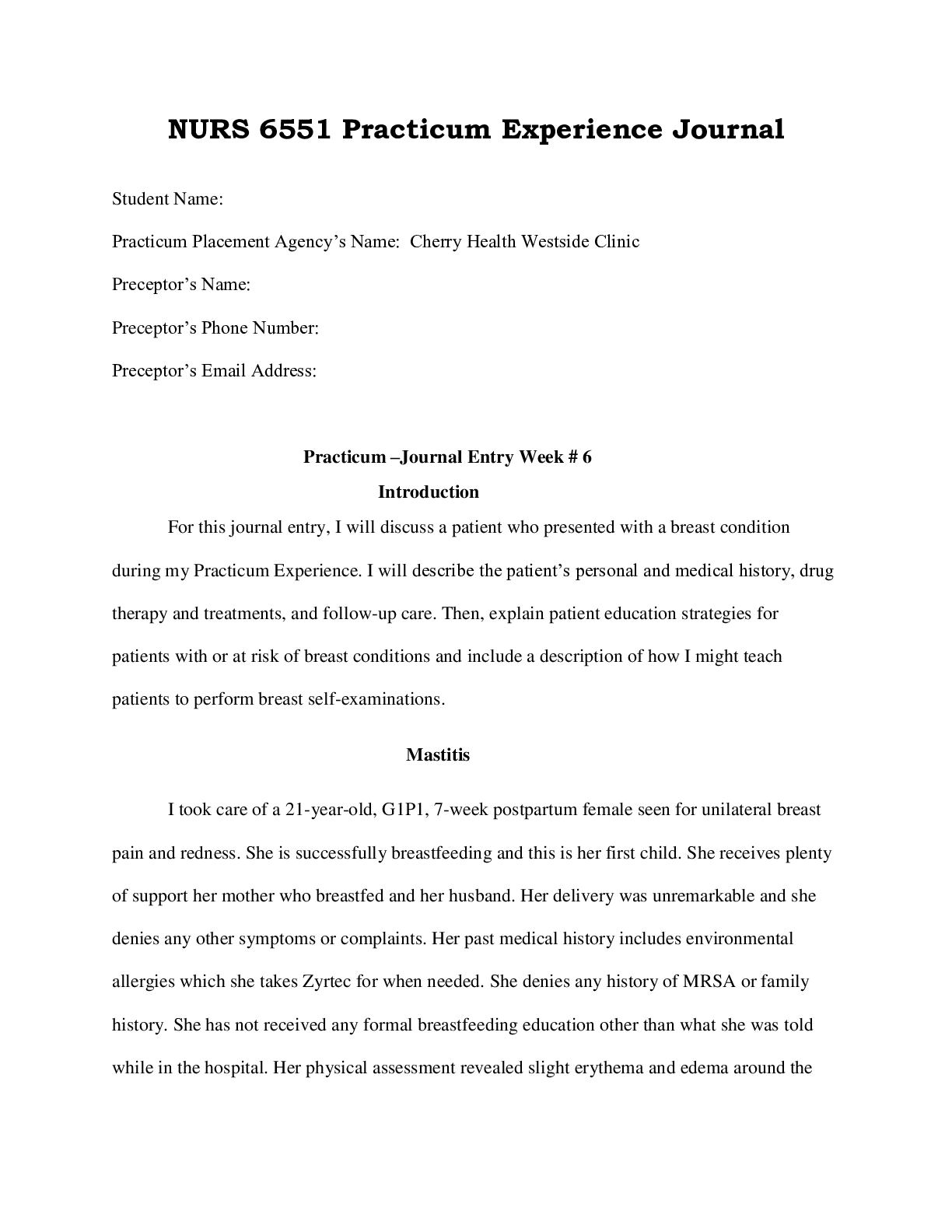

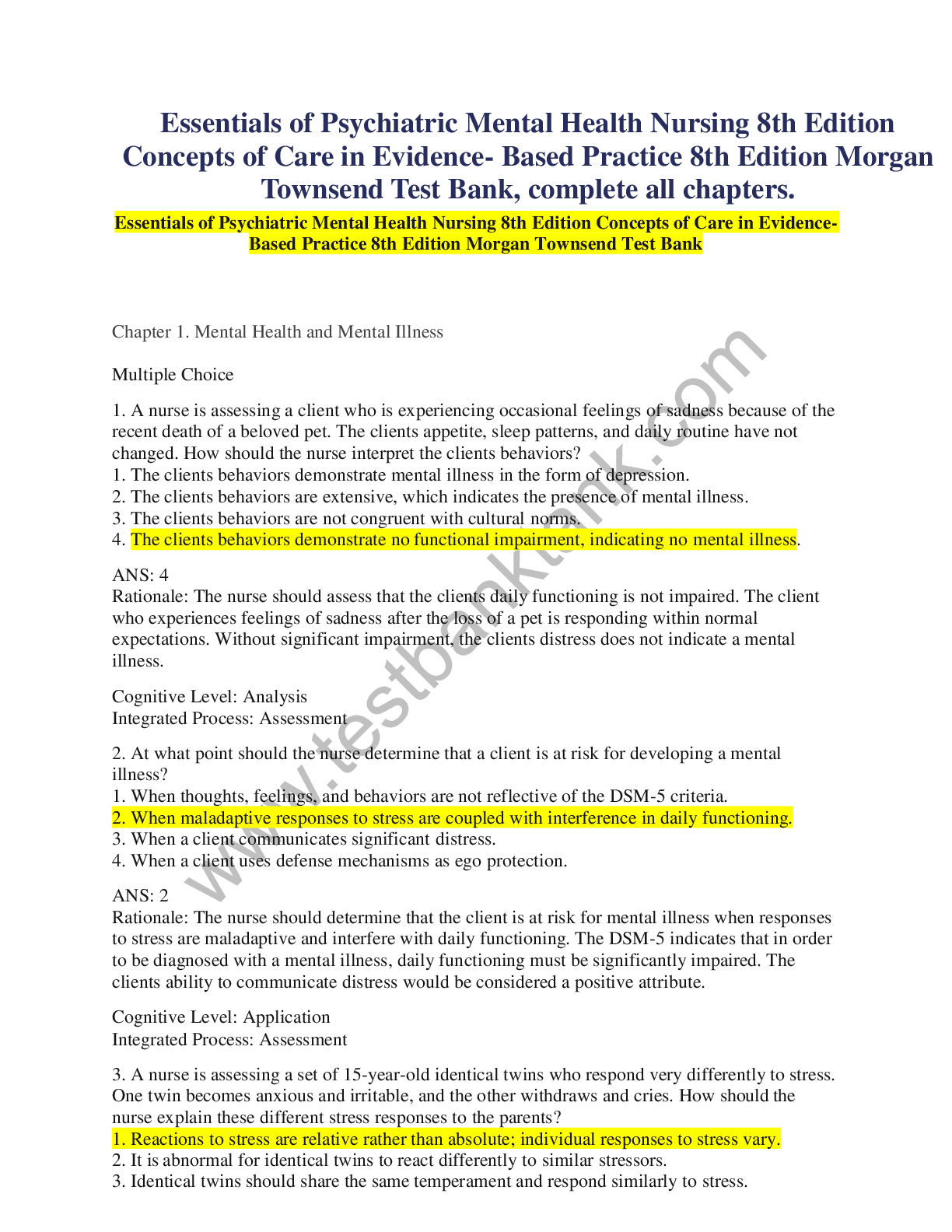
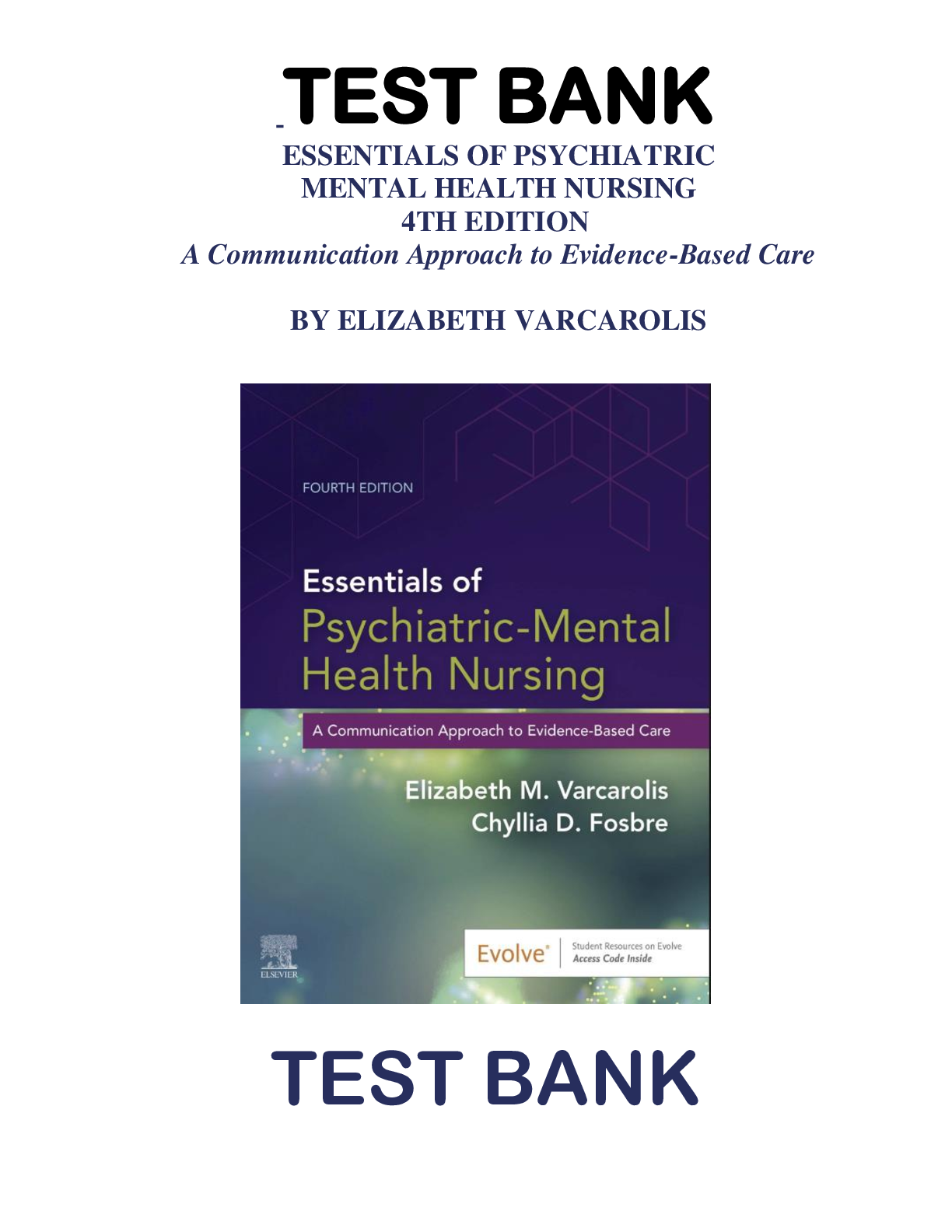
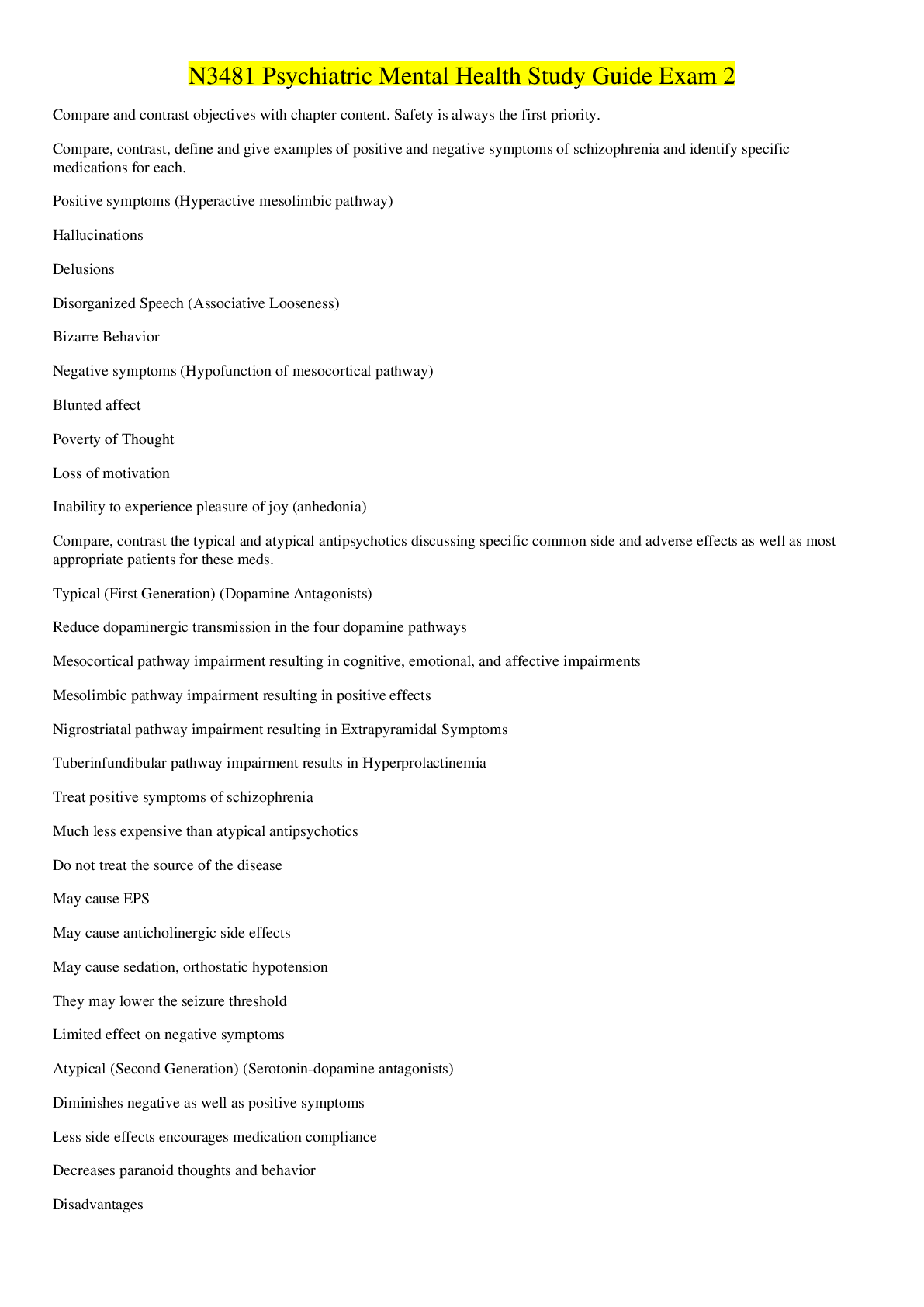
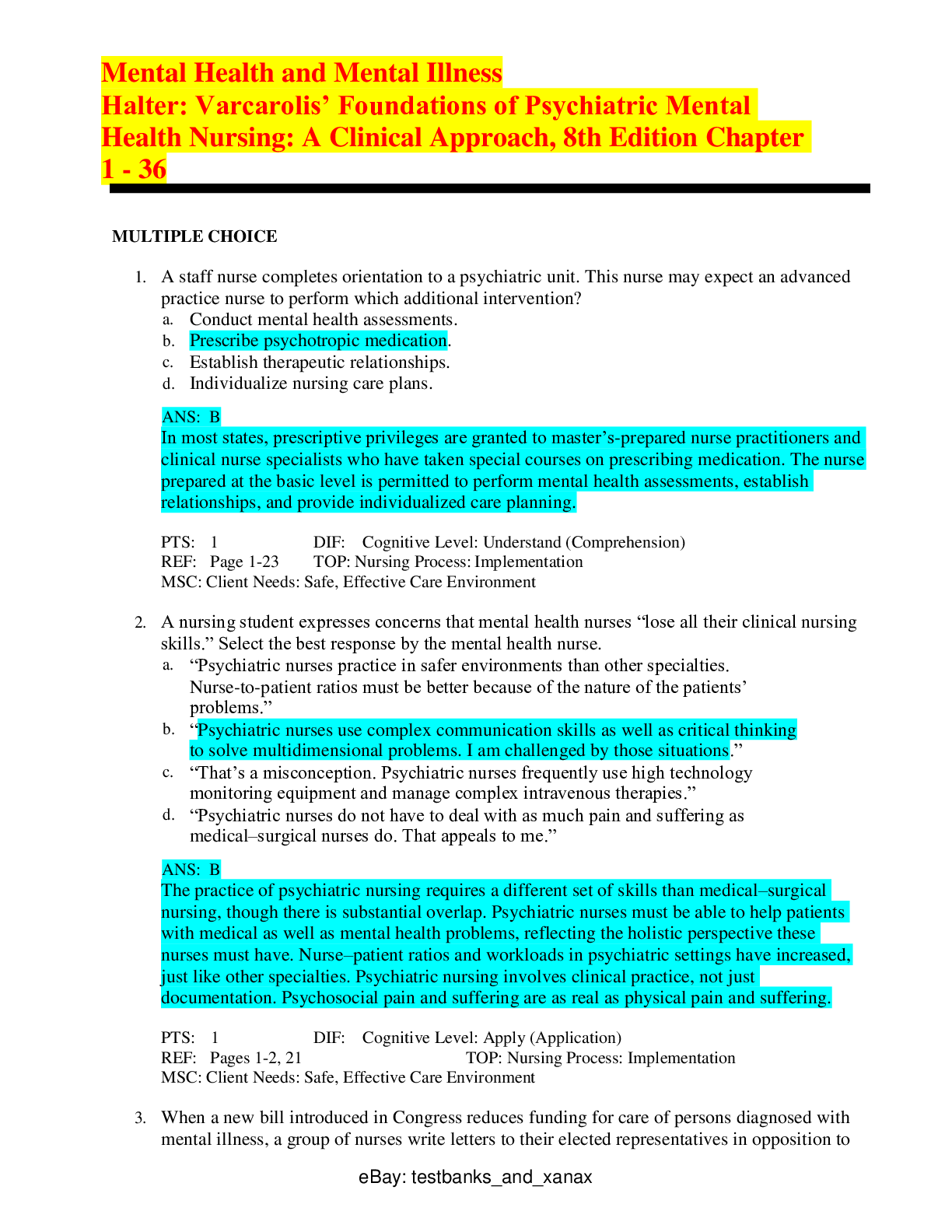
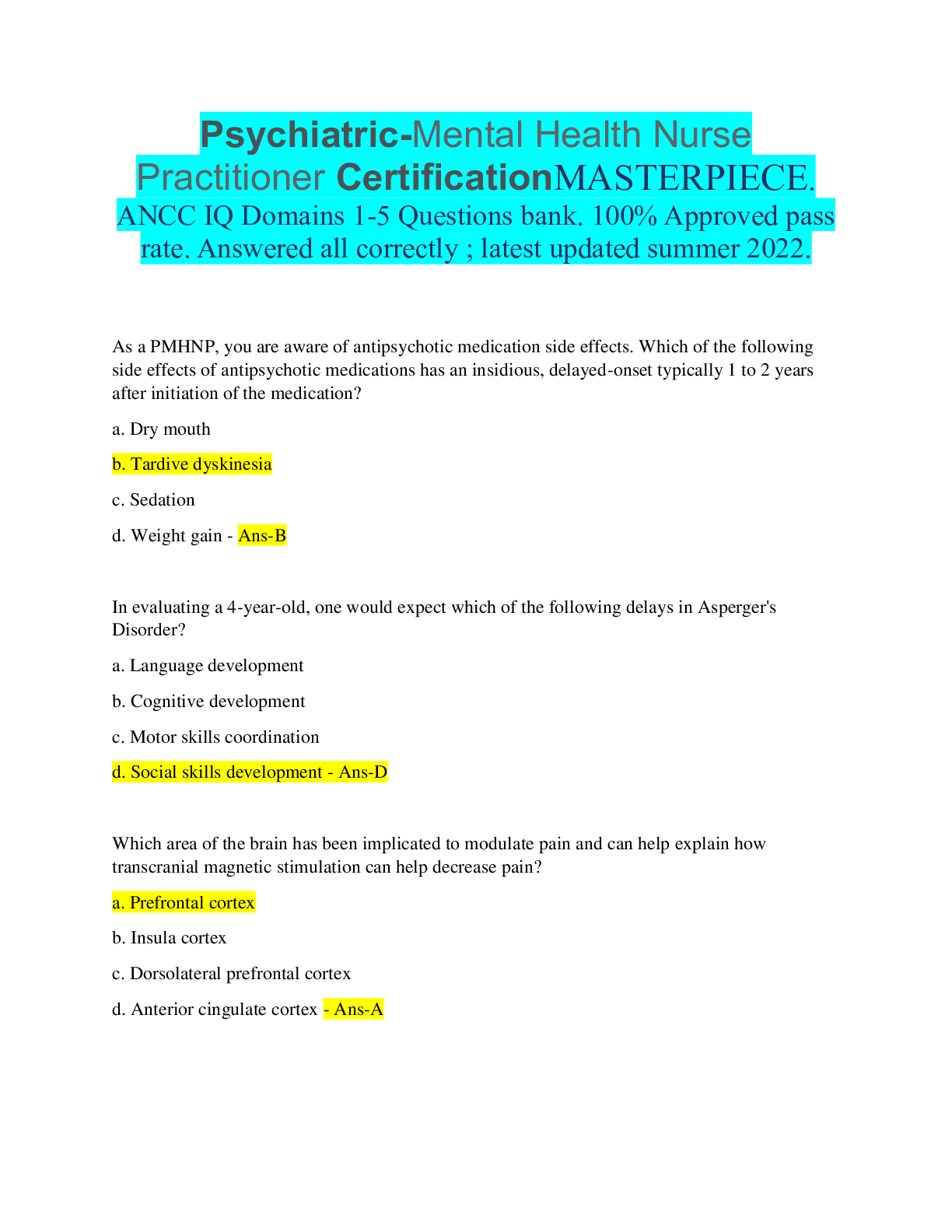
 (1).png)
.png)
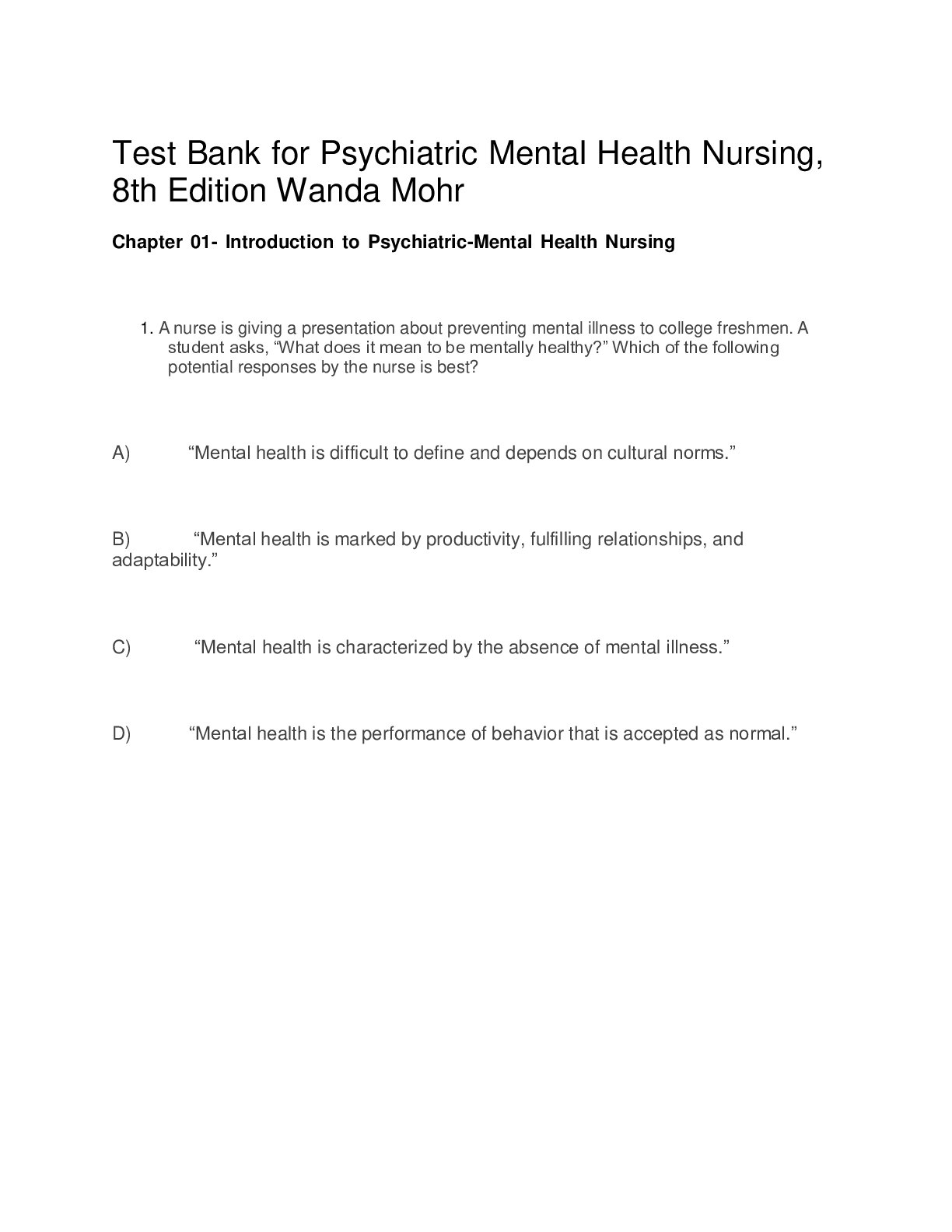
.png)


 Questions and Answers (latest Update).png)

